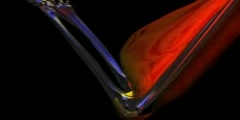How the Body Works : Movement and the Cerebellum
Movement and the Cerebellum The cerebellum, part of the hindbrain, is concerned with the regulation of coordination and balance. It is an oval-shaped structure with a central furrow, which is flanked on either side by a bulbous lobe. The furrow is called the vermis and the expanded lobes the hemispheres. The surface is covered with folds, or folia. In the illustration presented, a section through a folium has been drawn out and cut through to show its internal structure. The outer region of the cerebellum is known as the cortex, or gray matter. It contains two distinct layers of nerve cells, the molecular layer-containing stellate and basket cells, which process information within the cortex, and the granular layer-containing small granule cells and Golgi cells, which sift incoming information. The layers are separated from each other by a layer of purknje cells, which carry information concerning body movement out of the cerebellum. Beneath the cortex lies the white matter, which is composed of nerve fibers, mossy fibers and climbing fibers that pass in and out of the cerebellum. The Mossy fibers are a major route for information entering the cerebellum, while the climbing fibers carry information to the cells in the molecular layer of the cerebellar cortex. The cerebellum lies below the occipital lobes of the brain's cerebral hemispheres.
Channels: Medical
Tags: Movement and the Cerebellum
Uploaded by: sikadi ( Send Message ) on 07-07-2009.
Duration: 1m 36s













